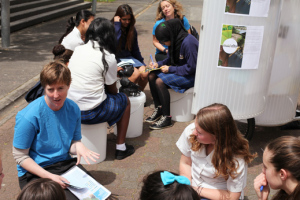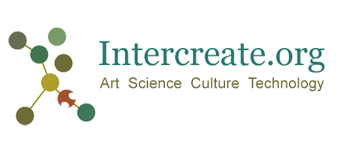
Fluid City is a SCANZ 2015 project, shown here is the version at James Cook High School, Manurewa, 16 October 2014. Photo by James Hutchinson.
For the SCANZ 2015 residency, we propose to redevelop the Fluid City content in relation to the local environment and cultures of the Taranaki region. This will be developed in the form of a short water film (for the roving cinema); interviews and stories from locals including tangata whenua from Parihaka marae, farmers, school children, artists, musicians, poets and other residents; and fragments of creative writing or environmental sound (for the roving vessel of stories); and fresh water samples collected from streams and other significant waterways around the Taranaki district (for the roving laboratory). We intend to gather this material in concert with and informed by the local hosts of the SCANZ residency.
In addition, a new site-specific choreographic performance (to be performed in and around the Fluid City site) will be created to accompany the water vessels. We will work with our hosts to attract locals to participate in the dance performance work, guided by a dance teacher from the Fluid City collective. Fluid City creates a space where the general public can engage informatively with ideas and issues around water sustainability, and can also contribute their knowledge and questions through, for example, writing postcards for display or telling stories which are then recorded and added to an interactive audio installation.
Fluid City is an installation for diverse communities of all ages that brings alive issues of water sustainability through a roaming science lab, cinema and vessel of stories. The project is a mobile and transportable art-science collaboration that brings researchers into contact with members of the public in ways that are informative, interactive and inventive. This work invites visitors into embodied engagements, to discover through kinaesthetic, tactile, auditory, visual and interrelational modes. It takes the form of three cupboard-like vessels (that we refer to as ‘roving reservoirs’) towed by bicycles. Each of the three vessels has a unique emphasis.
One is a mini-cinema that invites the passers-by to come in close and peer through a diving mask into the vessel to view a film about water. The film is a three-minute animation featuring water in a variety of abstract and functional forms (the reservoir, mountain stream, flowing across the road, entering a stormwater drain, spilling into its sink/the harbour or ocean), including mundane, everyday uses (irrigating the garden, boiling peas, taking a shower). Few words are employed. The moving image has proven captivating to all ages.
A second vessel is a scientific mini-laboratory that enables participants to test water samples collected from local waterways. The reconstructed mobile laboratory houses a powerful microscope and a range of test tubes on display. Participants don white lab coats and select a test tube sample, identifying its source from an accompanying map of the collection sites in their local catchment. The audience will be guided by a qualified microbiologist who can explain what is typically invisible to the naked eye: the microbial worlds of their waterways as active, colourful, alive – explaining differences in water quality that distinguish a forested stream from a polluted waterway.
The third vessel provides a space for people to sit (on upturned buckets with cushions) and listen through headphones to different voices sharing a variety of stories, poems, songs and scientific explanations about water in its myriad forms. The audience is also invited to share their personal memories and concerns about water through writing or drawing on postcards (which we will design) and to then contribute this writing to a kind of washing line set up along the river-side space. This will create a tapestry of stories, issues, thoughts and pictures of water reflecting a multiplicity of meanings and ideas.
